Comprehensive Guide to Flattening Lists with NumPy: Mastering numpy flatten list Techniques
numpy flatten list is a powerful technique used in data manipulation and preprocessing. This article will explore the various methods and applications of flattening lists using NumPy, a fundamental library for scientific computing in Python. We’ll dive deep into the numpy flatten list functionality, providing detailed explanations and practical examples to help you master this essential skill.
Understanding numpy flatten list Basics
Before we delve into the specifics of numpy flatten list, let’s first understand what flattening a list means and why it’s important in data processing.
Flattening a list refers to the process of converting a multi-dimensional array or nested list into a one-dimensional array. This operation is crucial in many data analysis and machine learning tasks, where uniform data structures are often required for processing.
NumPy, with its efficient array operations, provides several methods to flatten lists. The most common and straightforward method is the flatten() function, which is part of the numpy flatten list toolkit.
Let’s start with a simple example:
import numpy as np
# Create a 2D array
arr = np.array([[1, 2, 3], [4, 5, 6]])
print("Original array from numpyarray.com:")
print(arr)
# Flatten the array
flattened = arr.flatten()
print("Flattened array:")
print(flattened)
Output:

In this example, we create a 2D array and use the flatten() method to convert it into a 1D array.
This simple demonstration showcases the basic functionality of numpy flatten list. However, there’s much more to explore in terms of options and use cases.
Advanced numpy flatten list Techniques
While the basic flatten() method is useful, NumPy offers more advanced techniques for flattening lists and arrays. Let’s explore some of these methods:
Using numpy.ravel() for numpy flatten list
The numpy.ravel() function is another powerful tool in the numpy flatten list arsenal. It returns a contiguous flattened array and is often more memory-efficient than flatten().
Here’s an example:
import numpy as np
# Create a 3D array
arr = np.array([[[1, 2], [3, 4]], [[5, 6], [7, 8]]])
print("Original array from numpyarray.com:")
print(arr)
# Flatten using ravel()
flattened = np.ravel(arr)
print("Flattened array using ravel():")
print(flattened)
Output:

The ravel() function flattens the 3D array into a 1D array, demonstrating its capability in handling multi-dimensional arrays.
Flattening with Specific Order using numpy flatten list
Both flatten() and ravel() allow you to specify the order in which elements are flattened. The two main orders are ‘C’ (row-major, default) and ‘F’ (column-major).
Let’s see an example:
import numpy as np
# Create a 2D array
arr = np.array([[1, 2, 3], [4, 5, 6]])
print("Original array from numpyarray.com:")
print(arr)
# Flatten with C-order (row-major)
flattened_c = arr.flatten('C')
print("Flattened array (C-order):")
print(flattened_c)
# Flatten with F-order (column-major)
flattened_f = arr.flatten('F')
print("Flattened array (F-order):")
print(flattened_f)
Output:

This example demonstrates how the order parameter affects the resulting flattened array.
Handling Complex Data Structures with numpy flatten list
numpy flatten list techniques are not limited to simple numerical arrays. They can handle more complex data structures as well. Let’s explore some examples:
Flattening Arrays of Strings
NumPy can flatten arrays containing strings just as easily as numerical arrays:
import numpy as np
# Create an array of strings
arr = np.array([['apple', 'banana'], ['cherry', 'date']])
print("Original array from numpyarray.com:")
print(arr)
# Flatten the array
flattened = arr.flatten()
print("Flattened array:")
print(flattened)
Output:
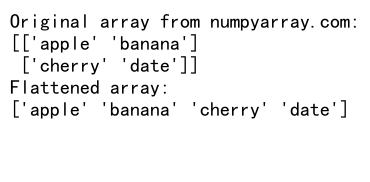
This example shows that numpy flatten list works seamlessly with string data types.
Flattening Mixed Data Types
NumPy can also handle arrays with mixed data types:
import numpy as np
# Create an array with mixed data types
arr = np.array([[1, 'two'], [3.0, True]])
print("Original array from numpyarray.com:")
print(arr)
# Flatten the array
flattened = arr.flatten()
print("Flattened array:")
print(flattened)
Output:
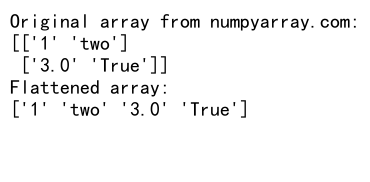
In this case, NumPy converts all elements to strings to maintain a consistent data type in the flattened array.
Practical Applications of numpy flatten list
Now that we’ve covered the basics and some advanced techniques, let’s explore practical applications of numpy flatten list in real-world scenarios.
Data Preprocessing for Machine Learning
In machine learning, it’s often necessary to flatten multi-dimensional data into a format suitable for model input. Here’s an example:
import numpy as np
# Simulating image data (3D array)
image_data = np.array([[[255, 0, 0], [0, 255, 0]], [[0, 0, 255], [255, 255, 255]]])
print("Original image data from numpyarray.com:")
print(image_data)
# Flatten for model input
flattened_data = image_data.flatten()
print("Flattened data for model input:")
print(flattened_data)
Output:
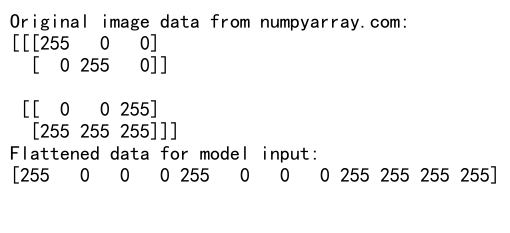
This example demonstrates how numpy flatten list can be used to prepare image data for a machine learning model that expects 1D input.
Time Series Analysis
In time series analysis, you might need to flatten multi-dimensional time series data:
import numpy as np
# Simulating multi-dimensional time series data
time_series = np.array([[1, 2, 3], [4, 5, 6], [7, 8, 9]])
print("Original time series data from numpyarray.com:")
print(time_series)
# Flatten for analysis
flattened_series = time_series.flatten()
print("Flattened time series:")
print(flattened_series)
Output:

This flattened representation can be useful for certain types of time series analysis or visualization.
Advanced numpy flatten list Scenarios
Let’s explore some more advanced scenarios where numpy flatten list techniques can be particularly useful.
Flattening Nested Lists
While NumPy primarily works with arrays, you can use it to flatten nested Python lists as well:
import numpy as np
# Create a nested list
nested_list = [[1, 2, 3], [4, [5, 6]], 7, [8, 9]]
print("Original nested list from numpyarray.com:")
print(nested_list)
# Convert to NumPy array and flatten
flattened = np.array(nested_list, dtype=object).flatten()
print("Flattened array:")
print(flattened)
Output:

Note that this method doesn’t fully flatten deeply nested structures, but it’s a start. For complete flattening of deeply nested lists, you might need to combine NumPy with recursive Python functions.
Flattening and Reshaping
Sometimes, you might need to flatten an array and then reshape it. numpy flatten list techniques can be combined with reshaping operations:
import numpy as np
# Create a 3D array
arr = np.array([[[1, 2], [3, 4]], [[5, 6], [7, 8]]])
print("Original array from numpyarray.com:")
print(arr)
# Flatten and reshape
flattened = arr.flatten()
reshaped = flattened.reshape(4, 2)
print("Flattened and reshaped array:")
print(reshaped)
Output:
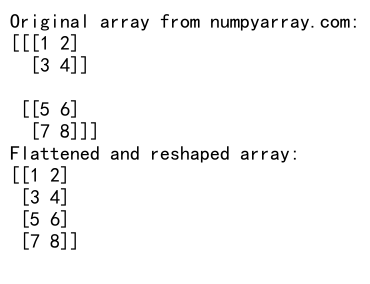
This example shows how you can use numpy flatten list to restructure your data in various ways.
Performance Considerations in numpy flatten list Operations
When working with large datasets, the performance of numpy flatten list operations becomes crucial. Let’s explore some performance aspects:
Memory Efficiency: flatten() vs ravel()
As mentioned earlier, ravel() can be more memory-efficient than flatten() in certain scenarios:
import numpy as np
# Create a large array
large_arr = np.random.rand(1000, 1000)
# Using flatten()
flattened = large_arr.flatten()
print("Memory usage of flattened array from numpyarray.com:")
print(flattened.nbytes)
# Using ravel()
raveled = large_arr.ravel()
print("Memory usage of raveled array:")
print(raveled.nbytes)
Output:

While the output will vary, you’ll often find that ravel() uses less memory, especially for large arrays.
Flattening Views vs Copies
The ravel() function returns a view of the original array when possible, which can be more efficient:
import numpy as np
# Create an array
arr = np.array([[1, 2], [3, 4]])
print("Original array from numpyarray.com:")
print(arr)
# Create a view using ravel()
view = arr.ravel()
print("Raveled view:")
print(view)
# Modify the view
view[0] = 99
print("Original array after modifying view:")
print(arr)
Output:
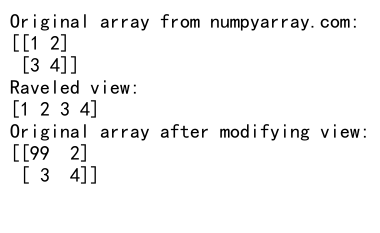
This example demonstrates that changes to the raveled view affect the original array, which can be either an advantage or a pitfall depending on your needs.
Combining numpy flatten list with Other NumPy Operations
numpy flatten list operations can be combined with other NumPy functions to perform complex data manipulations. Let’s explore some examples:
Flattening and Filtering
You can combine flattening with boolean indexing to filter data:
import numpy as np
# Create a 2D array
arr = np.array([[1, 2, 3], [4, 5, 6], [7, 8, 9]])
print("Original array from numpyarray.com:")
print(arr)
# Flatten and filter even numbers
flattened = arr.flatten()
even_numbers = flattened[flattened % 2 == 0]
print("Even numbers after flattening:")
print(even_numbers)
Output:

This example shows how numpy flatten list can be used in conjunction with boolean indexing for data filtering.
Flattening and Mathematical Operations
numpy flatten list can be combined with mathematical operations for data analysis:
import numpy as np
# Create a 3D array
arr = np.array([[[1, 2], [3, 4]], [[5, 6], [7, 8]]])
print("Original array from numpyarray.com:")
print(arr)
# Flatten and calculate statistics
flattened = arr.flatten()
mean = np.mean(flattened)
std = np.std(flattened)
print(f"Mean of flattened array: {mean}")
print(f"Standard deviation of flattened array: {std}")
Output:
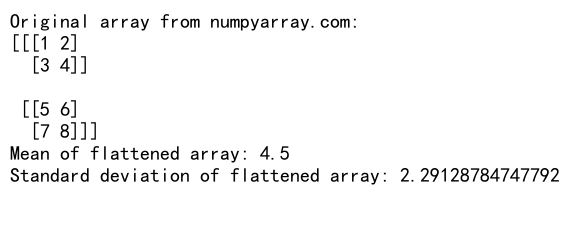
This example demonstrates how flattening can simplify the calculation of statistics across all dimensions of an array.
Handling Edge Cases in numpy flatten list Operations
When working with numpy flatten list, it’s important to be aware of potential edge cases and how to handle them:
Flattening Empty Arrays
Let’s see how NumPy handles flattening of empty arrays:
import numpy as np
# Create an empty 2D array
empty_arr = np.array([[]])
print("Empty array from numpyarray.com:")
print(empty_arr)
# Flatten the empty array
flattened = empty_arr.flatten()
print("Flattened empty array:")
print(flattened)
print("Shape of flattened empty array:", flattened.shape)
Output:
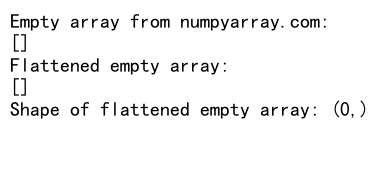
This example shows that NumPy correctly handles empty arrays, resulting in an empty 1D array.
Optimizing numpy flatten list for Large Datasets
When dealing with large datasets, optimizing numpy flatten list operations becomes crucial. Here are some techniques to improve performance:
Using numpy.ndarray.flat
For very large arrays, using the flat attribute can be more efficient than flatten():
import numpy as np
# Create a large 3D array
large_arr = np.random.rand(100, 100, 100)
print("Shape of large array from numpyarray.com:", large_arr.shape)
# Access elements using flat
first_ten = [x for x in large_arr.flat[:10]]
print("First ten elements using flat:")
print(first_ten)
Output:

The flat attribute provides an iterator over all elements of the array, which can be more memory-efficient for large arrays.
Combining flatten() with Slicing
For partial flattening or when you only need a subset of the flattened array, combining flatten() with slicing can be efficient:
import numpy as np
# Create a 3D array
arr = np.array([[[1, 2], [3, 4]], [[5, 6], [7, 8]]])
print("Original array from numpyarray.com:")
print(arr)
# Flatten only the first sub-array
partial_flat = arr[0].flatten()
print("Partially flattened array:")
print(partial_flat)
Output:

This technique allows you to flatten only the parts of the array that you need, potentially saving memory and computation time.
Advanced Applications of numpy flatten list
Let’s explore some more advanced applications of numpy flatten list in data analysis and scientific computing:
Image Processing with numpy flatten list
In image processing, flattening can be useful for certain operations:
import numpy as np
# Simulate a grayscale image
image = np.array([[50, 100, 150], [200, 250, 0], [75, 125, 225]])
print("Original image from numpyarray.com:")
print(image)
# Flatten and normalize
flat_image = image.flatten()
normalized = (flat_image - np.min(flat_image)) / (np.max(flat_image) - np.min(flat_image))
print("Normalized flattened image:")
print(normalized)
Output:
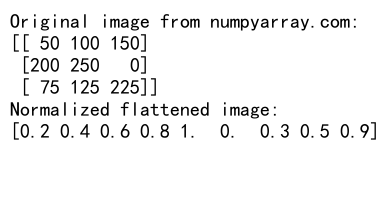
This example demonstrates how flattening can be used in image processing tasks like normalization.
Feature Engineering in Machine Learning
numpy flatten list can be useful in feature engineering for machine learning:
import numpy as np
# Simulate feature matrices
feature_matrix1 = np.array([[1, 2], [3, 4]])
feature_matrix2 = np.array([[5, 6], [7, 8]])
print("Feature matrix 1 from numpyarray.com:")
print(feature_matrix1)
print("Feature matrix 2 from numpyarray.com:")
print(feature_matrix2)
# Combine and flatten for feature vector
combined_features = np.hstack((feature_matrix1.flatten(), feature_matrix2.flatten()))
print("Combined feature vector:")
print(combined_features)
Output:

This example shows how flattening can be used to combine different feature matrices into a single feature vector for machine learning models.
Common Pitfalls and How to Avoid Them
When using numpy flatten list, there are some common pitfalls to be aware of:
Modifying Flattened Views
As mentioned earlier, ravel() returns a view when possible. This can lead to unexpected behavior if you’re not careful:
import numpy as np
# Create a 2D array
arr = np.array([[1, 2], [3, 4]])
print("Original array from numpyarray.com:")
print(arr)
# Create a flattened view
flat_view = arr.ravel()
print("Flattened view:")
print(flat_view)
# Modify the flattened view
flat_view[0] = 99
print("Original array after modifying flattened view:")
print(arr)
Output:
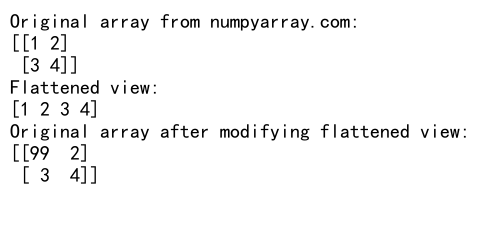
To avoid unintended modifications, use flatten() instead of ravel() when you need a copy.
Flattening Non-Contiguous Arrays
Flattening non-contiguous arrays can sometimes lead to unexpected results:
import numpy as np
# Create a non-contiguous array
arr = np.array([[1, 2, 3], [4, 5, 6]])[:, ::2]
print("Non-contiguous array from numpyarray.com:")
print(arr)
# Flatten the array
flattened = arr.flatten()
print("Flattened array:")
print(flattened)
Output:
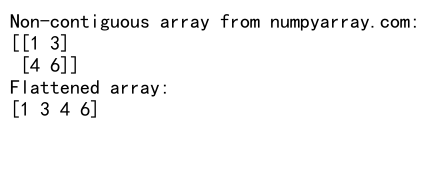
In this case, flatten() creates a contiguous copy of the data. Be aware that this can have performance implications for large arrays.
Conclusion: Mastering numpy flatten list
Throughout this comprehensive guide, we’ve explored the various aspects of numpy flatten list operations. From basic usage to advanced techniques and real-world applications, we’ve covered a wide range of topics to help you master this essential NumPy functionality.
Key takeaways include:
- The basic
flatten()method is straightforward and creates a copy of the data. ravel()can be more memory-efficient but returns a view when possible.- numpy flatten list operations can handle various data types and structures.
- Combining flattening with other NumPy operations enables powerful data manipulations.
- Performance considerations are important, especially for large datasets.
- Understanding potential pitfalls can help you use numpy flatten list more effectively.
By mastering numpy flatten list techniques, you’ll be better equipped to handle complex data structures and perform efficient data preprocessing for various scientific computing and machine learning tasks. Remember to consider the specific requirements of your project when choosing between different flattening methods, and always be mindful of memory usage and performance implications when working with large datasets.
As you continue to work with NumPy and data manipulation, keep exploring and experimenting with numpy flatten list operations. They are a powerful tool in your data science toolkit, enabling you to transform and prepare data efficiently for a wide range of analytical and computational tasks.